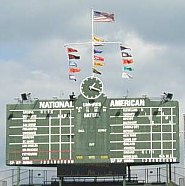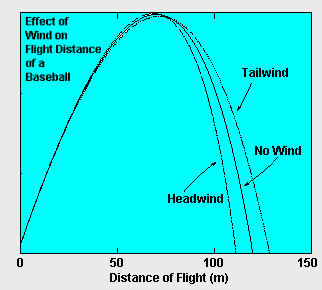Weather Almanac for April 2004
WEATHER AND BASEBALL

"The true harbinger of spring is not crocuses or swallows returning
to Capistrano, but the sound of the bat on the ball." — Bill Veeck
I am in full agreement with the late Mr Veeck, owner of several baseball teams including the Chicago White Sox. Veeck was a true baseball fan, and during his later years was frequently seen enjoying a Cubs game (his father was once club president) from the sunny bleachers of beautiful Wrigley Field. Baseball and weather are my greatest loves in life, and I played slopitch as an adult for many years. My team Apache was based in Guelph, Ontario, and club-founder Dave Kendrick would always start our spring workouts on the closest Saturday to April 15th. So while Americans sweated their tax returns, I oiled my glove, took practice swings in the living room and prayed for the snow to melt. Early spring weather in southern Ontario can range from snowy to summery, and in the twelve years I was with the team, I think we had them all.
We even had one brief practice in the snow. That year, a spring snow covered the diamonds, and we had only a quick workout to slake our cravings. One moment in that workout, however, will be forever etched in my mind. I am sure you remember the cartoons where someone throws a ball into the snow and it rolls downhill getting bigger and bigger until a giant snowball reaches the intended victim. Well, I must douse that myth. As we played a bit on that snow-covered field, a ground ball hit toward me rolled through the sticky snow. But instead of forming that larger, round snowball of the cartoons, the softball collected snow in a growing ring as it rolled toward me. Just as it was about to reach my glove, the now-ringed ball stopped and fell to its side, looking like a failed planet Saturn. I was so overcome by laughter that the tears rolling down my cheeks froze on my beard. I still chuckle as I write this.
I wrote about weather and sport a few years ago in conjunction with a major snowstorm that affected the conference football championship game between Michigan and Ohio States. I could also tell you stories about the effects of weather on the players, particularly baseball players where touch is an important part of the game. Yes, "bees" do live in bats when it is cold, swarms of them. But, weather affects the game itself, perhaps more than any other ball sport except golf.
Ballparks
I take you back to Beautiful Wrigley Field. As we enter the ballpark, it is best to look at the flags flying over the scoreboard, because they may tell you something about the coming game. If the flags are flapping wildly in an outbound (from home plate to the outfield) wind, be ready for a high-scoring, home-run-laden game. If the wind direction is reversed, look for a pitcher's duel and low scores. Located near the Lake Michigan shore, games at Wrigley Field have been affected by wind and weather for ninety years. If our tickets are for the centerfield bleachers, we can absorb enough Chicago sun to keep us warm through the coming winter. Rain, heat, humidity all play a part in the Wrigley Field experience, affecting the game as much as our comfort.

Wrigley is not the only park notorious for its weather effects but its day-to-day swings are perhaps best reported and thus etched in the minds of most fans. In the spring, when I hear that a Cubs home game had an unusually high score, the first thought that pops into my head is: "Wind's blowing out at Wrigley." If you are of the older generation of baseball fan, you might remember the cold, swirling winds of Candlestick Park in San Francisco lifting pitcher Stu Miller from the mound during the 1961 All-Star Game. Coors Field in Denver is a noted hitter's park, the low air pressure in the Mile-High City giving added distance to balls hit there. Houston built the Astrodome, the first indoor facility, because the oppressive summer heat and humidity wore down the players.
Not only do the current atmospheric conditions affect the course of the game, but changes in the park's microclimate can change its nature as well. One of the more well-documented impacts came when a new scoreboard was installed in Baltimore's old Memorial Stadium. Its presence blocked the incoming winds and allowed balls to travel further more regularly, thus changing the stadium from a pitcher's to a hitter's park. Such impacts of weather and climate on a ball game and particular ballpark were recognized by astute students of the game, and managers altered their lineups and game strategies to accommodate the condition. Winds blowing strong to left field? Use more right-handed hitters in the line-up and start a right-handed, sinker-ball pitcher.
The ultimate expression of understanding the weather nuances of a ballpark came in the 1980s when the wind engineering firm of Rowan Williams Davies & Irwin Inc (my former employer) used a wind tunnel to study the design of the forthcoming Baltimore ballpark Camden Yards. In addition to providing design safety and fan comfort information, the studies also showed the wind-induced quirks of the playing field before it was constructed. Since that initial study, the firm has worked on most of the new ballparks, including the new Philadelphia ballpark to be opened this spring. Today, computer models have been added to the ballpark design toolbox to understand its wind microclimate.
Some Physics of Baseball Flight
 Wind has the biggest influence on the trajectory of a baseball once it has been hit or thrown. It is the ultimate wildcard in a game because it is capable of changing its nature over hours, minutes, and even seconds. A sudden gust can blow a pop fly just out of a fielder's reach for a game-winning hit or hold up a deep fly, changing a game-winning home run to a long out. The wind will push the ball in the direction it is blowing, left or right, further out or further in, than its trajectory would be under calm conditions. Wind has the biggest influence on the trajectory of a baseball once it has been hit or thrown. It is the ultimate wildcard in a game because it is capable of changing its nature over hours, minutes, and even seconds. A sudden gust can blow a pop fly just out of a fielder's reach for a game-winning hit or hold up a deep fly, changing a game-winning home run to a long out. The wind will push the ball in the direction it is blowing, left or right, further out or further in, than its trajectory would be under calm conditions.
A headwind's speed, and therefore its force, can greatly reduce a ball's travel distance by increasing the frictional drag. In contrast, a tailwind decreases the drag because the air moves with the ball, and it flies further. A baseball that would travel about 400 feet (120 metres) on a day with calm winds would travel about 445 feet (135 metres) with a 15-mph (25 km/h) wind behind it.
If we neglect wind effect for a moment, a baseball flying freely through the air is affected by two major forces: gravity and friction. Gravity pulls the ball downward and affects every ball the same. The friction component, the drag force, depends on the properties of the air through which the ball flies, namely its air temperature, pressure and humidity. These all act to alter the local density of the air. The less dense the air, the fewer air molecules are present to exert drag on the ball. Therefore, the less the air density, the greater the distance of flight.
In dry air, we can express the density of air with the following simple formula.
Density = (pressure)/(temperature*constant)
At a constant temperature, the lower the pressure, the lower the density and the further a ball's flight (all other factors being equal). For example, in the thin Denver air, a baseball travels nine percent further than one hit at sea level, say at New York's Yankee Stadium. Thus, a 400-ft (120-metre) home run at Yankee Stadium would fly about 436 ft (133 metres) at Coors Field.
If pressure remains constant, the density decreases with increasing temperature, so balls fly further on a hot summer day than during a cool spring day. Again, with all other factors constant, a ball hit on a hot, 95 oF (35 oC) day will travel a further 20 feet (6 m) than the same hit on a cool, 45 oF (7.2 oC) day.
If we combined the two influences, a equally hit ball flying over a hot field at Coors Field would travel about 60 ft (18 m) further than at a cold Yankee Stadium. Differences in humidity can also be a factor, though its two impacts can negate each other. Humid air is less dense than dry air so that 400-ft (120-metre) drive hit on a humid day, in theory, would travel an additional 15 feet (4.6 m) than that hit on a very dry day. However, in real situations, the ball also changes under humid conditions and becomes heavier and less elastic. The net effect of humidity is that baseballs actually travel a slightly shorter distance in humid air.
Not only is hitting affected by these weather conditions, so are pitching and fielding. Again comparing Denver and New York, Roger Clemens' fastball will reach the plate quicker in Denver, but his curve ball will break about 3 inches (7.6 cm) less because the frictional drag, which is lower at elevation, is what makes a breaking pitch curve. Fielders have to move faster to catch up to batted balls at elevation. Some estimate an infielder's range decreases about a foot (30 cm) and an outfielder's about 9 feet (2.7 m) in Denver compared to a sea-level park.
Of course, rain, and even snow or fog, can also impact a game by altering visibility, traction and the friction on balls and bats, but games are usually halted for safety reasons during such conditions. Lightning and other severe weather associated with thunderstorms will also halt games for player and fan safety. Even a good sunny day can play havoc with a game by affecting the player's ability to see the small white ball in flight, as can partial shading of the field.
Written by
Keith C. Heidorn, PhD, THE WEATHER DOCTOR,
April 1, 2004
The Weather Doctor's Weather Almanac Weather and Baseball
©2004, Keith C. Heidorn, PhD. All Rights Reserved.
Correspondence may be sent via email to: see@islandnet.com.
For More Weather Doctor articles, go to our Site Map.

I have recently added many of my lifetime collection of photographs and art works to an on-line shop where you can purchase notecards, posters, and greeting cards, etc. of my best images.

Home |
Welcome |
What's New |
Site Map |
Glossary |
Weather Doctor Amazon Store |
Book Store |
Accolades |
Email Us
|



|








